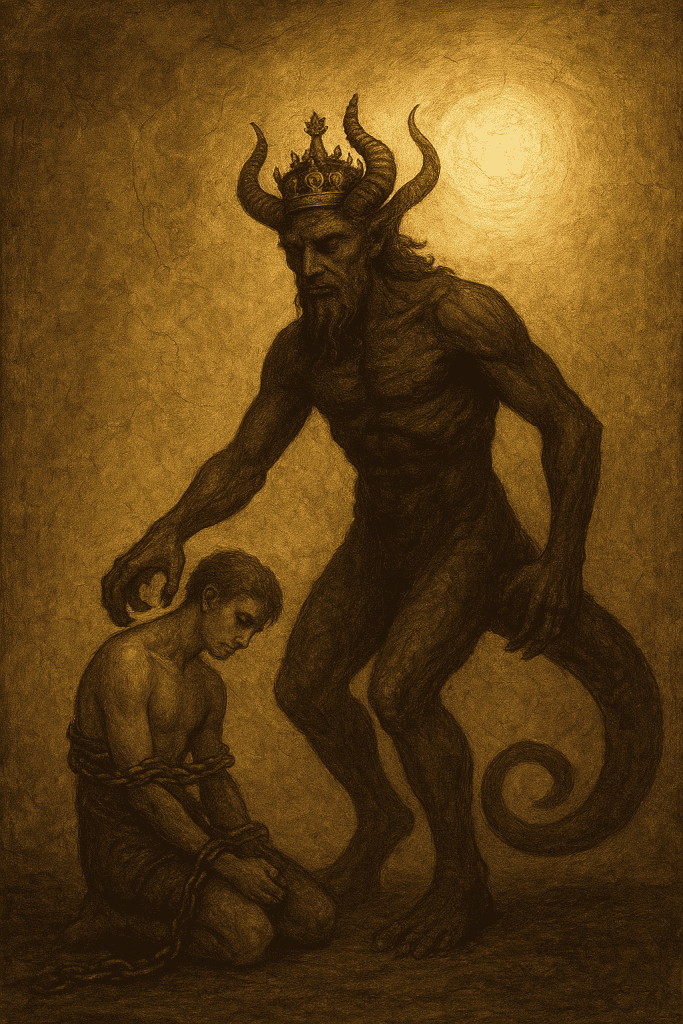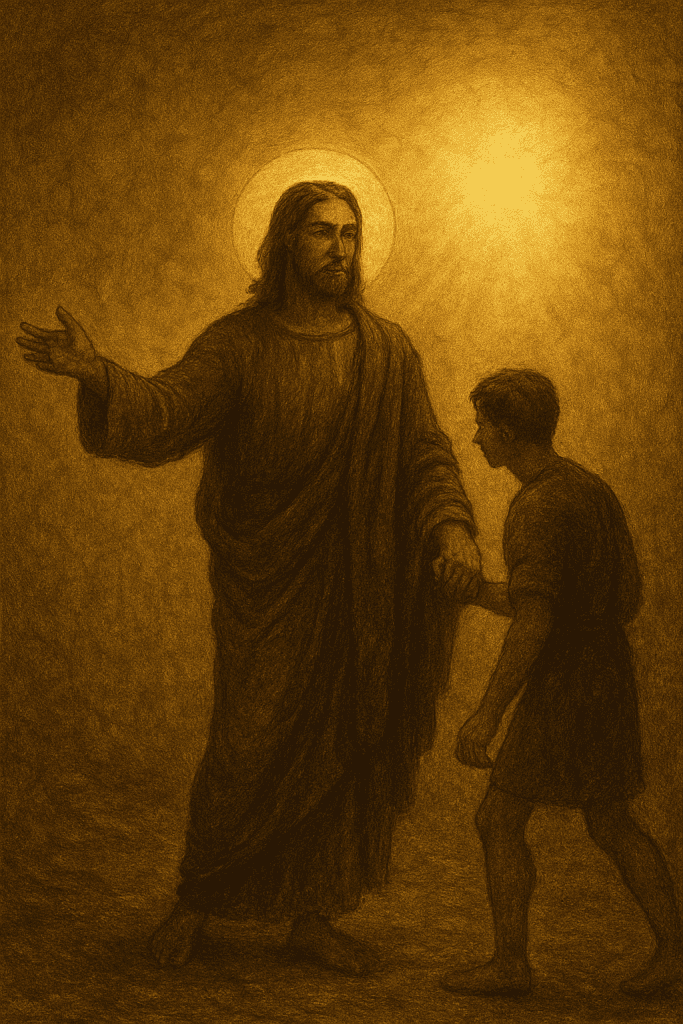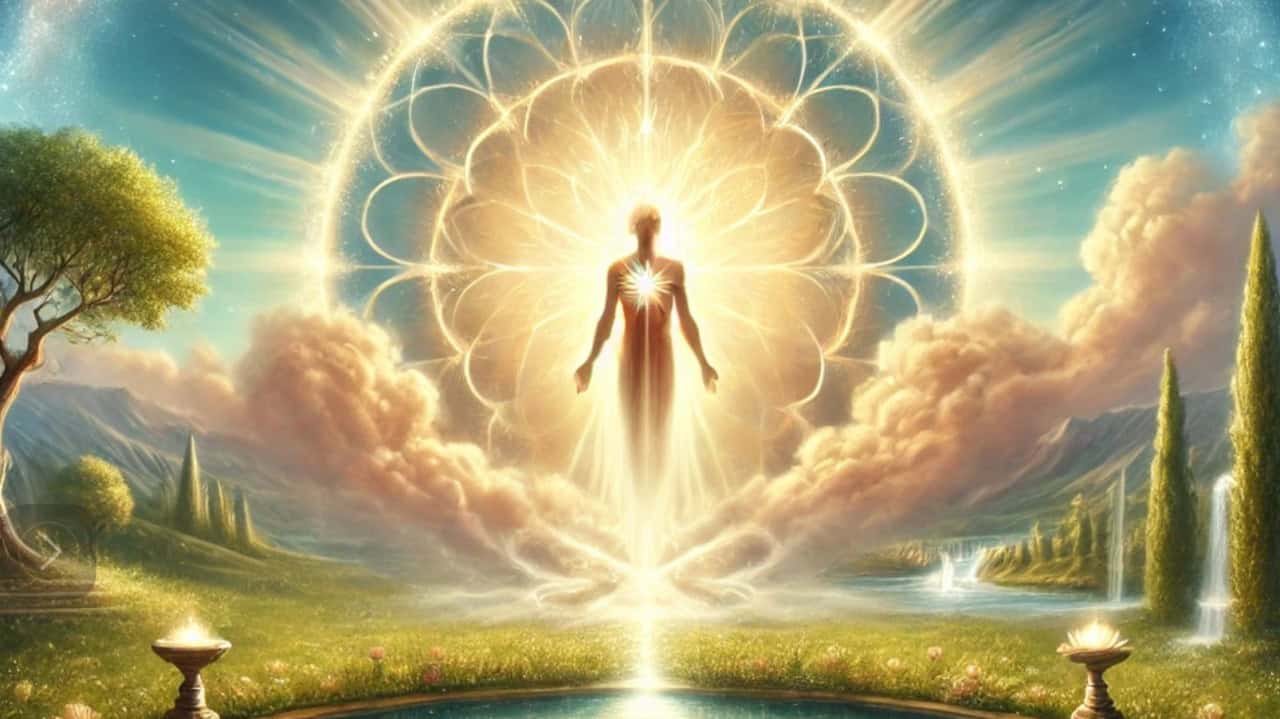A Gnostic Christian Perspective (Full Article)
For many readers the idea sounds shocking: the God who speaks in Genesis, who gives the law through Moses and who calls himself “I am the Lord, and there is no other” (Isaiah 45:5) — what if that figure is not the ultimate God at all, but a lesser craftsman, a blind architect who mistakes himself for the Source? This is not a modern polemic but a central claim of Gnostic Christianity, one of the earliest and most radical streams of reflection in the Christian world.
This article lays out that claim clearly and with evidence: the Gnostic cosmology that distinguishes the true, ineffable Source (the Monad) from the creator-figure (the Demiurge); how some Gnostic texts recast biblical narratives (including the Garden of Eden); how Jesus functions — in Gnostic accounts — as revealer rather than legal redeemer; and what it all means if you bring to the question the conviction that “all is Mind” and human beings are co-creators. I use quotations from key Nag Hammadi texts (Apocryphon of John, Hypostasis of the Archons, Gospel of Thomas, Gospel of Philip) and point to modern scholarship that frames the debate.
Part I — The Gnostic Vision of God and Creation
A different beginning
One of the clearest differences between Gnostic and later orthodox Christian thought is how each locates the ultimate divine reality. In mainstream Christian theology God is simultaneously transcendent and immanent, creator and Father. For most Gnostics, however, the highest Reality is utterly transcendent — the ineffable Source or Monad — and the biblical Creator (YHWH) is not that Source but a lesser being. To appreciate the difference you need the basic shape of the Gnostic story.
Monad, Aeons, Sophia
Gnostic myth describes a single, ineffable principle (the Monad) from which emanations — called Aeons — flow. These Aeons together constitute the Pleroma (Fullness). Among the Aeons is Sophia (Wisdom). Sophia’s story is the turning point: moved by desire to know the Father directly, she acts without her consort and produces something imperfect. From that imperfect act comes a being who is ignorant of the Pleroma and yet powerful enough to fashion a material cosmos. That being is the Demiurge (also named Yaldabaoth, Saklas, Samael in various texts).
The Apocryphon of John—one of the clearest expositions preserved in the Nag Hammadi codices—describes this dramatic origin: the newborn archon declares himself God, boasting, “I am God and there is no other.” The Gnostic author treats this boast not as revelation but as the revealing mark of an impostor: a being who, by his very jealousy and self-assertion, shows that another God exists beyond him.[Apocryphon of John]
The Demiurge and the Old Testament God
When Gnostics read the Hebrew scriptures, they saw the Demiurge reflected in passages where the Creator is jealous or jealous-sounding — where God rends the world with law. Isaiah’s "I am the Lord, and there is no other" becomes, in their eyes, an expression of the Demiurge’s ignorance: only the blind craftsman would insist upon singularity so fiercely, because he cannot know the fullness beyond himself. The Apocryphon of John explicitly links the Demiurge’s statement to this kind of divine language and calls it proof that this creator is a lesser god — a tyrant of the visible order rather than the hidden Source.

Evil mythological creature with horns and crown overpowering a man, symbolising temptation or inner struggle in spiritual or psychological themes.
Creation as confinement
Because the Demiurge is architect and jealous ruler, the created world is (in Gnostic thought) a realm of bondage: matter, law, and the powers (archons) function to keep sparks of the divine imprisoned in bodies. The Gnostics interpret the creation narrative in Genesis not as an unqualified good but as the origin of the material prison that traps the spiritual element. According to the Hypostasis of the Archons, the archons shape humanity from earth, thinking they give life — yet the life comes from a higher breath, a spark placed secretly in humanity by Sophia. Thus the human condition is paradoxical: made by inferior hands yet carrying the presence of the higher Pleroma.
Part II — Jesus the Revealer and the Re-Reading of Genesis
Christ as revealer, not legal redeemer
If the cosmos is the Demiurge’s work, then the central problem is not moral failure in a juridical sense but forgetfulness. Souls have forgotten their origin in the Pleroma. Salvation consists not in satisfying a cosmic judge but in awakening the memory (gnosis) of who we are and where we come from. On that account, Jesus’ mission is revelatory: he comes from the higher realms to pronounce knowledge that breaks the spell.
The Apocryphon of John records the Savior telling John he has come to teach "what is, and what was, and what will come to pass, so that you may understand the invisible world and the world that is visible."[Apocryphon of John] The Gospel of Thomas, a sayings collection treasured by many Gnostic groups, places the emphasis on inner realization: “The kingdom is inside of you, and it is outside of you. When you come to know yourselves, then you will be known.” (Thomas 3)
This is not merely spiritualized speech; it functions as an epistemic reorientation. The Gnostic Jesus does not instruct followers primarily in rites or penalty-avoidance; he instructs them in how to perceive the hidden reality and to awaken the spark within.

A depiction of Jesus Christ with a young person, illustrating themes of faith, mentorship, and divine compassion in Christian religious artwork.
The serpent and the Garden reimagined
One of the most controversial reinterpretations in Gnostic texts is the recasting of the Eden narrative. Where orthodox tradition reads the serpent as the tempter, a corrupter (and thus often as Satan), some Gnostic writings cast the serpent as an agent of awakening. In the Hypostasis of the Archons, the serpent becomes the "instructor" who tells Adam and Eve truths the Creator forbids and thereby enables their self-awareness. In this retelling, the Demiurge’s prohibition against knowledge is not moral protection but protective imprisonment — knowledge (gnosis) liberates the spark. To accept that reading is to invert the moral frame of the original story: the so-called Fall becomes the first act of defiance against cosmic ignorance.
Paul, law, and the god of this age
Gnostic readings often reinterpret Pauline texts too. When Paul speaks of “the god of this age [who] has blinded the minds of unbelievers” (2 Cor 4:4), Gnostics saw in that phrase a direct reference to the Demiurge. What orthodox Christians often read as reference to Satan can, in the Gnostic frame, be an indictment of the creator himself: the visible god who sustains the systems of law and the cosmos that obscure the higher truth.
Part III — All Is Mind: The Spark, Co-creation, and Liberation
All is Mind, and the Demiurge’s mind
The Hermetic dictum “All is Mind” dovetails with Gnostic metaphysics well. For the Gnostics, the Demiurge fashions not merely matter but the experienced world — a mental/ontological configuration shaped by limited perspective. The Demiurge’s creation is a projection grounded in ignorance; it is convincing and necessarily persuasive, but it is not the totality of being.
If consciousness is the ground of reality, then the Demiurge’s mind is only a partial mind. The Pleroma’s Mind (the Monad) remains the deeper ground. Human beings, carrying a spark (pneuma) from the Pleroma, have within them the capacity to re-align their consciousness with the Source. In practical terms, that means the human task is to awaken — to shift perspective from the Demiurge’s narrative to the Pleroma’s remembrance.
The spark and the inner work
Gnostic texts speak repeatedly of a divine spark placed in humanity by Sophia or as a remnant of the Pleroma. The Apocryphon of John explains that the Archons fashioned Adam but could not give him true life; the life that animates Adam comes from the higher breath — the spark — deposited by the higher realm. The Gospel of Thomas captures the practical imperative: “If you bring forth what is within you, what you bring forth will save you.” (Thomas 70)
Gnosis is therefore not mere abstract doctrine but a way of knowing — contemplative, experiential, and transformative. It changes how one perceives power, law, ritual, and the self. If “all is Mind,” then awakening is a change in mind and perception — a cognitive-spiritual revolution that undermines the Demiurge’s dominion.
Implications for co-creation
Once you accept that the ground of reality is consciousness — and that some fraction of that ground is present within each person — co-creation becomes a spiritual responsibility. The Gnostic spark, once awake, can engage the Demiurge’s created field not by reinforcing it but by creating other patterns of perception that reflect Pleromic truth: kindness, non-attachment to the false claims of the world, and acts of remembrance. In that sense, Gnostic spirituality is quietly revolutionary: it reclaims human agency from the powers of ignorance.
Archaeology, Textual Evidence, and the Question of Priority
Nag Hammadi and the textual picture
The principal primary evidence for the Gnostic worldview as we know it comes from the Nag Hammadi Library (discovered 1945), a Coptic codex collection preserving dozens of tractates (Apocryphon of John, Gospel of Thomas, Hypostasis of the Archons, Gospel of Philip, Pistis Sophia, etc.). These texts, though copied in Coptic in the 3rd–4th centuries CE, preserve Greek or earlier traditions. Other papyri fragments (e.g., Oxyrhynchus) confirm that some sayings attributed to Thomas circulated early.
Which came first?
A critical and contested question is whether Gnostic mythic outlines predate, influence, or simply reinterpret the scriptural corpus. Scholarship is divided and nuanced:
- Some scholars (e.g., Elaine Pagels in The Gnostic Gospels) emphasize early diversity: Christianity from the start was pluralistic, and Gnostic strains may preserve older or alternative interpretive traditions.
- Others (e.g., Michael Williams, Karen King) caution about broad claims; “Gnosticism” as a coherent, unified movement is itself a modern category that can obscure diversity and development. Many Gnostic cosmologies appear to be second-century elaborations synthesizing Hellenistic, Platonic, Jewish, and Christian elements.
- Many specialists conclude the truth lies between: certain sayings and traditions (some Thomas logia, for example) may derive from very early oral material, while the full mythic systems (Sophia’s fall, Yaldabaoth as Demiurge with a garden narrative inversion, archons) likely cohere in the second century as theological synthesis.
So while Gnostic reinterpretation of biblical material is demonstrable, the claim that “the Bible’s stories are drawn from Gnosticism” is too strong unless qualified: both drew from shared cultural pools (Ancient Near Eastern myths, Hellenistic speculation) and cross-fertilized one another in the complex religious ecology of the first few centuries.
Parallels in the Ancient Near East
Genesis itself stands in a wider ANE context (e.g., Enūma Eliš, Atra-ḫasis), where divine artisans fashion the world, where gods contest order, and where humans are formed from earth. Gnostic myth reworks that matrix but reinterprets the moral valence. Where ANE epics celebrate creation as order over chaos, Gnostic myth often depicts creation as a tragic by-product of a disordered desire within the Pleroma.
Reading the Bible with Gnostic Eyes — What Changes?
Re-valuing stories
When read through a Gnostic lens, many canonical episodes take on different valence:
- Genesis: The Creator’s prohibition against the tree of knowledge is interpreted as a strategy to keep humanity ignorant; the serpent becomes a vehicle for awakening.
- Exodus and the Law: The law that orders and binds can be read as regimes imposed by the Demiurge to keep humans in the created order, rather than purely righteous ordinances from an ultimate Father.
- Prophetic pronouncements (the jealous speech of Yahweh) can be reinterpreted as the Demiurge’s boast — proof of a lesser being’s insecurity.
This is not “throwing out” the Bible so much as re-reading it through an alternative metaphysical framework. For Gnostics, the Bible contains usable materials — but materials that must be decoded and placed in a wider cosmological map.
Why This Matters Today
A critique of literalist religion
Gnosticism’s pointed critique of a jealous, law-centered deity speaks powerfully to those who have experienced religious systems as controlling rather than liberating. Re-casting the Creator as Demiurge helps to explain certain features of religious authority that seem punitive or controlling.
A psychology of awakening
Beyond polemics, Gnostic texts articulate a compelling psychology: spiritual ignorance is a condition to be remedied by inner transformation, and religious life is a path of awakening. The spiritual practices associated with Gnostic groups — contemplative listening, interpretive reading, ritual remembrance — are aimed at recovering memory of origin.
Co-creation and ethics
If one accepts the principle that “all is Mind,” then ethical life becomes aligned with awakening: to think and act in ways that reveal more light into the world. In that sense, Gnosticism can be ethically consequential: the awakened person rejects the Demiurge’s dominion by living differently in thought, relationship, and creation.
Conclusion — The Old Current That Still Speaks
From the Gnostic Christian vantage, the God of the Bible — especially as portrayed in certain Old Testament passages — is not the highest, ineffable Source but the Demiurge: the craftsman of the visible order with limited knowledge and jealous power. The true God is beyond names and forms, residing in the Pleroma; Salvation is not judicial appeasement but the inner awakening to that reality. Jesus is the revealer of that truth; Sophia is the feminine Aeon whose error and remedy lie at the heart of the cosmic drama.
Does this mean orthodox Christianity is entirely wrong? Not necessarily. Many Gnostics read the same scriptures and found in them seeds of truth that orthodox readings later cultivated differently. The relationship is complex: shared stories, divergent metaphysics, mutual reworkings.
If you want a single practical takeaway: read the biblical narratives twice — once in the way many were taught, and once as a set of symbols that may carry a deeper, inward message. If the world is indeed primarily mental (a field of mind), then the most radical human act is to awaken to the mind within and remember the Source. That is the heart of the Gnostic call.
Selected Primary Texts & Further Reading
Primary (translations in commonly available editions)
- Apocryphon of John (Nag Hammadi Codex II) — translations in The Nag Hammadi Library in English (ed. James M. Robinson) and The Nag Hammadi Scriptures (ed. Marvin Meyer).
- Gospel of Thomas (Logia) — early sayings collection, Nag Hammadi; see scholarly translations (Lambdin/Wisse).
- Hypostasis of the Archons — Nag Hammadi tractate.
- Gospel of Philip; Pistis Sophia — Nag Hammadi and related Coptic/Greek texts.
Secondary (scholarly introductions & analysis)
- Elaine Pagels, The Gnostic Gospels (1979) — accessible introduction to Nag Hammadi discoveries and early Christian diversity.
- Bentley Layton (ed.), The Gnostic Scriptures (1987) — primary texts and commentary.
- Hans Jonas, The Gnostic Religion (1958) — classic study of Gnostic systems and their spiritual meaning.
- Karen L. King, What Is Gnosticism? (2003) — careful modern critique of categories and methodology.
- Michael A. Williams, Rethinking “Gnosticism” (1996) — methodological reassessment of the term and the phenomenon.
- Mark S. Smith, The Early History of God — for ANE parallels and the background of Israelite religion.
Do Humans Really Want Gnosis? The Brutal Honesty Question
© 2025 Fluid Thoughts. Licensed under Creative Commons BY-NC 4.0.
You may share or adapt this work for non-commercial purposes only.
Before saving, open your browser’s print dialog and turn off Headers and footers (the title and URL line).
Chrome / Opera / Edge: Menu → Print → uncheck Headers and footers • Firefox: More settings → turn off Print headers and footers • Safari: already clean


